« Best-of-N Strategy » : différence entre les versions
(Page créée avec « == en construction == == Définition == xxxxxxx == Français == ''' XXXXXX''' Voir aussi '''reward hacking problem''' == Compléments == '' à faire'' <!--The BoN strategy does not scale with the number of samples N due to the reward hacking problem. Particularly significant in scenarios where the AI model may not have a singularly deterministic output but can benefit from generating a spectrum of possibilities to increase the chance of achieving a higher qua... ») |
Aucun résumé des modifications |
||
| (Une version intermédiaire par le même utilisateur non affichée) | |||
| Ligne 2 : | Ligne 2 : | ||
== Définition == | == Définition == | ||
Stratégie d'échantillonnage qui consiste à générer ''N'' sorties à partir d'un '''[[modèle]]''' et à sélectionner la meilleure sortie parmi les ''N'' échantillons à l'aide d'une '''[[fonction de récompense]]''' ou d'un critère prédéfini selon un '''[[modèle de récompense]]'''. Cette méthode ne nécessite pas de phase d''''[[entraînement]]''' supplémentaire. | |||
Voir aussi '''reward hacking problem''' et '''[[fonction de distance de Kullback-Leibler]]''' | |||
== Français == | == Français == | ||
''' XXXXXX''' | ''' XXXXXX''' | ||
== Compléments == | == Compléments == | ||
'' | Cette stratégie ne s'adapte pas au nombre d'échantillons ''N'' en raison du problème de '''piratage de la récompense'''. Cela est particulièrement important dans les scénarios où le '''[[Intelligence artificielle|modèle d'intelligence artificielle]]''' ne peut avoir un résultat déterministe unique, mais peut bénéficier de la génération d'un spectre de possibilités pour augmenter les chances d'obtenir un résultat de meilleure qualité ou plus pertinent sur le plan contextuel. | ||
< | <hr/> | ||
Ses applications sont multiples : '''[[génération automatique de textes]]''', '''[[Reconnaissance automatique de la parole|reconnaissance vocale]]''' ou synthèse d'images. | |||
== Anglais == | == Anglais == | ||
''' Best-of-N Strategy''' | ''' Best-of-N Strategy''' | ||
| Ligne 21 : | Ligne 21 : | ||
''' BoN''' | ''' BoN''' | ||
<!--Sampling strategy that involves generating N outputs from a model and selecting the most preferred output among the N samples with the help of a reward function or predefined criterion according to a process reward model. This method does not require an additional training phase.--> | <!--Sampling strategy that involves generating N outputs from a model and selecting the most preferred output among the N samples with the help of a reward function or predefined criterion according to a process reward model. This method does not require an additional training phase.--> | ||
<!--The BoN strategy does not scale with the number of samples N due to the reward hacking problem. Particularly significant in scenarios where the AI model may not have a singularly deterministic output but can benefit from generating a spectrum of possibilities to increase the chance of achieving a higher quality or more contextually relevant result. | |||
Its applications are broad, including text generation, voice recognition, or image synthesis, where the diversity among outputs can lead to significant improvements in performance or user satisfaction.--> | |||
== Sources == | == Sources == | ||
[https://arxiv.org/html/2502.12668v1 Source : arxiv] | [https://arxiv.org/html/2502.12668v1 Source : arxiv] | ||
Dernière version du 29 juin 2025 à 14:52
en construction
Définition
Stratégie d'échantillonnage qui consiste à générer N sorties à partir d'un modèle et à sélectionner la meilleure sortie parmi les N échantillons à l'aide d'une fonction de récompense ou d'un critère prédéfini selon un modèle de récompense. Cette méthode ne nécessite pas de phase d'entraînement supplémentaire.
Voir aussi reward hacking problem et fonction de distance de Kullback-Leibler
Français
XXXXXX
Compléments
Cette stratégie ne s'adapte pas au nombre d'échantillons N en raison du problème de piratage de la récompense. Cela est particulièrement important dans les scénarios où le modèle d'intelligence artificielle ne peut avoir un résultat déterministe unique, mais peut bénéficier de la génération d'un spectre de possibilités pour augmenter les chances d'obtenir un résultat de meilleure qualité ou plus pertinent sur le plan contextuel.
Ses applications sont multiples : génération automatique de textes, reconnaissance vocale ou synthèse d'images.
Anglais
Best-of-N Strategy
Best-of-N
BoN
Sources
Contributeurs: Arianne Arel










